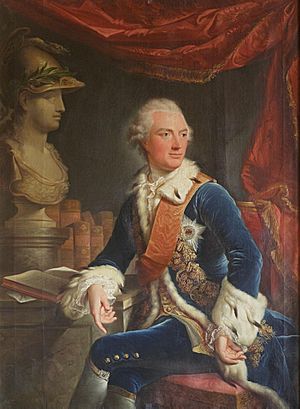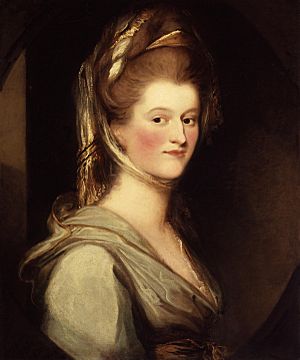Alexander, Margrave of Brandenburg-Ansbach facts for kids
Quick facts for kids
Christian Friedrich Carl Alexander
|
|
|---|---|
 |
|
| Born | 24 February 1736 Ansbach |
| Died | 5 January 1806 (aged 69) Benham Park, Speen, Berkshire, England |
| Noble family | Hohenzollern |
| Spouse(s) |
Princess Frederica Caroline of Saxe-Coburg-Saalfeld
(m. 1754; died 1791) |
| Father | Charles William Frederick, Margrave of Brandenburg-Ansbach |
| Mother | Princess Friederike Luise of Prussia |
Christian Friedrich Carl Alexander (born February 24, 1736 – died January 5, 1806) was an important ruler in Germany. He was the last Margrave (a type of prince or ruler) of two areas called Bayreuth and Ansbach. These areas were in a region called Franconia. He later sold these lands to the King of Prussia. Both Alexander and the King of Prussia belonged to the same powerful family, the House of Hohenzollern.
Contents
About His Life
Alexander's parents were Charles William Frederick, Margrave of Brandenburg-Ansbach, and Princess Friederike Luise of Prussia. His mother was the daughter of King Frederick William I of Prussia. This made her the sister of Frederick II of Prussia, a famous king. She was also a granddaughter of the British King George I. This meant she was a niece of King George II, who was ruling Britain when Alexander was young.
When Alexander was very young, his older brother, Carl Frederick August, sadly passed away in 1737. This made Alexander the next in line to rule his family's land. From 1748 to 1759, he went to Utrecht to study. He also traveled to places like Turin and Savoy.
On November 22, 1754, Alexander married Princess Frederica Caroline of Saxe-Coburg-Saalfeld in Coburg.
On August 3, 1757, Alexander became the Margrave of Brandenburg-Ansbach. The main palace of his land was in Ansbach. However, Alexander liked his hunting estate and country home in Triesdorf more. He made many changes there. He updated the "White Castle" and the "Red Castle" for himself. He also built other beautiful homes like the Villa Sandrina and the "Round Villa" (Villa Rotunda) on his estate.
In 1758, Alexander started a porcelain factory in Ansbach. He also worked on improving farming by bringing in new types of sheep. In 1769, he also gained control of the principality of Bayreuth. This happened because of old family laws of the House of Hohenzollern.
In 1780, Alexander started his own bank. It was called the Hochfürstlich-Brandenburg-Anspach-Bayreuthische Hofbanco. This bank later became a very large bank in Bavaria. He wanted to manage his own money and keep his earnings within his own control.
Helping in the American Revolutionary War
One way Alexander earned money was by sending soldiers to help King George III of Great Britain. These soldiers were paid to fight in the American Revolutionary War. Alexander was in charge of about 1,644 soldiers. About 1,183 of them returned home in 1783. The Margrave also sent more soldiers to Holland.
With the money he earned from this, he paid off many of his land's debts. When he became ruler in 1757, his land owed about 5,000,000 guilders. By the time he stopped being ruler 34 years later, the debt was much lower, only about 1,500,000 guilders.
The End of His Rule
| Ansbach | Bayreuth | |
|---|---|---|
| 1792 | Prussia | Prussia |
| 1805 | France | ↓ |
| 1806 | Bavaria | ↓ |
| 1807 | ↓ | France |
| 1810 | ↓ | Bavaria |
| ... | ↓ | ↓ |
| 1871 | Germany | Germany |
On January 16, 1791, Alexander decided to sell his lands to Prussia. A deal was made where Prussia would pay Alexander 300,000 guilders every year. On December 2, he officially signed a paper in Bordeaux, France, saying he would no longer be the Margrave. This is called an abdication.
After Giving Up His Rule
Alexander's first wife, Frederica Caroline, passed away on February 18, 1791. She had been living in Unterschwaningen. Soon after, on May 19 of the same year, Alexander left Triesdorf and moved to England. On October 13 or 30, 1791, in Lisbon, Alexander married Elizabeth Craven, Baroness Craven. She was the daughter of the Earl of Berkeley. Her first husband had recently passed away.
Alexander and his new wife moved to England as private citizens. They spent their time raising horses. By December 1791, he found a home near the River Thames called Brandenburg House. In 1798, he bought another estate called Benham Park near Newbury in Berkshire. Alexander passed away on January 5, 1806, at the age of 69. He had been sick with a lung illness. Today, there is a memorial for him in St Mary's Church in Speen. It simply says, "In Memory of the Margrave of Anspach, who died at Benham 5th January 1806."
The region Alexander used to rule changed hands many times after he left. In 1805, Prussia gave the Principality of Ansbach to France. Then, in 1806, Ansbach became part of the Kingdom of Bavaria. After a big battle in 1806, the Principality of Bayreuth also went to the French. In 1810, Bayreuth was also taken by Bavaria. In 1871, Bavaria became part of the new German Empire. Today, it is a state within modern Germany.
His Coat of Arms
See Also
 In Spanish: Alejandro de Brandeburgo-Ansbach para niños
In Spanish: Alejandro de Brandeburgo-Ansbach para niños



